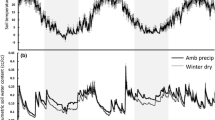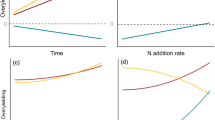Abstract
Climate warming and increased atmospheric nitrogen deposition are both predicted to alter the primary productivity of grass-dominated systems in the coming decades. In field experiments, while both factors can have substantial effects on productivity in the initial years, further changes can be delayed by lags in plant species composition responses. However, the effects of experiment age can be confounded by annual variability in environmental conditions, and a replicate experiment established at a later time is therefore needed to separate these effects. We added new warming and nitrogen plots to an ongoing (14 year-old) field experiment in a grass-dominated temperate old field to compare the short-term vs. long-term treatment effects on plant productivity and species composition, while controlling for interannual environmental variability. We predicted treatment effects on relative species abundances would be most pronounced in the old plots. Although treatment responses of productivity (specifically to N addition) were highest in the old plots in the first year, by the second year there were no interactions between treatment and plot age. Moreover, there were no plot age effects on plant species composition, which was associated with continued dominance of non-native grasses. Our results therefore suggest that despite initial increases in productivity in response to global change, dominance by non-native grasses can suppress the emergence of further long-term treatment effects on productivity by inhibiting the responses of other species.





Similar content being viewed by others
Availability of data and material
The datasets used and/or analyzed during the current study are available from the corresponding author on reasonable request.
Code availability
Not applicable.
References
Aerts R (2006) The freezer defrosting: global warming and litter decomposition rates in cold biomes. J Ecol 94:713–724. https://doi.org/10.1111/j.1365-2745.2006.01142.x
Alexander JM, Chalmandrier L, Lenoir J, Burgess TI, Essl F, Haider S, Kueffer C, McDougall K, Milbau A, Nuñez MA, Pauchard A, Rabitsch W, Rew LJ, Sanders NJ, Pellissier L (2018) Lags in the response of mountain plant communities to climate change. Global Change Biol 24:563–579. https://doi.org/10.1111/gcb.13976
Bell TH, Klironomos JN, Henry HAL (2010) Seasonal responses of extracellular enzyme activity and microbial biomass to warming and nitrogen addition. Soil Sci Soc Am J 74:820–828. https://doi.org/10.2136/sssaj2009.0036
Cleland EE, Chiariello NR, Loarie SR, Mooney HA, Field CB (2006) Diverse responses of phenology to global changes in a grassland ecosystem. Proc Natl Acad Sci USA 103:13740–13744. https://doi.org/10.1073/pnas.0600815103
de Vries FT, Bardgett RD (2016) Plant community controls on short-term ecosystem nitrogen retention. New Phytol 210:861–874. https://doi.org/10.1111/nph.13832
Deák B, Valkó O, Kelemen A, Török P, Miglécz T, Ölvedi T, Lengyel S, Tóthmérész B (2011) Litter and graminoid biomass accumulation suppresses weedy forbs in grassland restoration. Plant Biosystems 145:730–737. https://doi.org/10.1080/11263504.2011.601336
Fu G, Zhang X, Zhang Y, Shi P, Li Y, Zhou Y, Yang P, Shen Z (2013) Experimental warming does not enhance gross primary production and above-ground biomass in the alpine meadow of Tibet. J Appl Remote Sens 7:073505
Fu YH, Piao S, Delpierre N, Hao F, Hänninen H, Liu, et al (2018) Larger temperature response of autumn leaf senescence than spring leaf-out phenology. Glob Change Biol 24:2159–2168. https://doi.org/10.1111/gcb.14021
Galloway JN, Dentener FJ, Capone DG, Boyer EW, Howarth RW, Seitzinger SP, Asner GP, Cleveland CC, Green PA, Holland EA, Karl DM, Michaels AF, Porter JH, Townsend AR, Vöosmarty CJ (2004) Nitrogen cycles: past, present, and future. Biogeochemistry 70:153–226. https://doi.org/10.1007/s10533-004-0370-0
Gibson DJ, Newman JA (2019) Grasslands and Climate Change. Cambridge University Press, Cambridge, UK
Hagerty TP, Kingston MS (1992) The soils of middlesex county volume 1 report no. 56 of the Ontario centre for soil resource evaluation. Agriculture Canada, Research Branch
Harte J, Torn MS, Chang F-R, Feifarek B, Kinzig AP, Shaw R, Shen K (1995) Global warming and soil microclimate: results from a meadow-warming experiment. Ecol Appl 5(1):132–150. https://doi.org/10.2307/1942058
Henry HAL, Hutchison JS, Kim MK, McWhirter BD (2015) Context matters for warming: interannual variation in grass biomass responses to 7 Years of warming and N addition. Ecosystems 18:103–114. https://doi.org/10.1007/s10021-014-9816-y
Hodge A (2004) The plastic plant: root responses to heterogeneous supplies of nutrients. New Phytol 162(1):9–24. https://doi.org/10.1111/j.1469-8137.2004.01015.x
Hoeppner SS, Dukes JS (2012) Interactive responses of old-field plant growth and composition to warming and precipitation. Glob Change Biol 18:1754–1768. https://doi.org/10.1111/j.1365-2486.2011.02626.x
Hou D, He W, Liu C, Qiao X, Guo K (2019) Litter accumulation alters the abiotic environment and drives community successional changes in two fenced grasslands in Inner Mongolia. Ecol Evol 9:9214–9224. https://doi.org/10.1002/ece3.5469
Huang W, Dai J, Wang W, Li J, Feng C, Du J (2020) Phenological changes in herbaceous plants in China’s grasslands and their responses to climate change: a meta-analysis. Int J Biometeorol 64:1865–1876. https://doi.org/10.1007/s00484-020-01974-1
Hutchison JS, Henry HAL (2010) Additive effects of warming and increased nitrogen deposition in a temperate old field: plant productivity and the importance of winter. Ecosystems 13:661–672. https://doi.org/10.1007/s10021-010-9344-3
IPCC (2021) Climate change 2021: the physical science basis. In: Masson-Delmotte V, Zhai P, Pirani A, Connors SL, Péan C, Berger S, Caud N, Chen Y, Goldfarb L, Gomis MI, Huang M, Leitzell K, Lonnoy E, Matthews JBR, Maycock TK, Waterfield T, Yelekçi O, Yu R, Zhou B (eds) Contribution of working group I to the sixth assessment report of the intergovernmental panel on climate change
Jeong S (2020) Autumn greening in a warming climate. Nat Clim Chang 10:712–713. https://doi.org/10.1038/s41558-020-0852-7
Kelemen A Török P, Valkó O, Miglécz T, Tóthmérész B, Scheiner S (2013) Mechanisms shaping plant biomass and species richness: plant strategies and litter effect in alkali and loess grasslands. J Veg Sci 24(6):1195–1203. https://doi.org/10.1111/jvs.12027
Komatsu KJ, Avolio ML, Lemoine NP, Isbell F, Grman E, Houseman, et al (2019) Global change effects on plant communities are magnified by time and the number of global change factors imposed. Proc Natl Acad Sci USA 116:17867–17873. https://doi.org/10.1073/pnas.1819027116
Lebauer DS, Treseder K (2008) Nitrogen limitation of net primary productivity in terrestrial ecosystems is globally distributed. Ecology 89:371–379. https://doi.org/10.1890/06-2057.1
Lin D, Xia J, Wan S (2010) Climate warming and biomass accumulation of terrestrial plants: a meta-analysis. New Phytol 188:187–198. https://doi.org/10.1111/j.1469-8137.2010.03347.x
Ludlow MM, Muchow RC (1990) A critical evaluation of traits for improving crop yields in water-limited environments. Adv Agron 43:107–153
O’Mara FP (2012) The role of grasslands in food security and climate change. Annals Bot 110(6):1263–1270. https://doi.org/10.1093/aob/mcs209
Price MV, Waser NM (1998) Effects of experimental warming on plant reproductive phenology in a subalpine meadow. Ecology 79:1261–1271. https://doi.org/10.2307/176741
Rustad LE, Campbell JL, Marion GM, Norby RJ, Mitchell MJ, Hartley AE et al (2001) A meta-analysis of the response of soil respiration, net nitrogen mineralization, and aboveground plant growth to experimental ecosystem warming. Oecologia 126:543–562. https://doi.org/10.1007/s004420000544
Savage J, Vellend M (2015) Elevational shifts, biotic homogenization and time lags in vegetation change during 40 years of climate warming. Ecography 38(6):546–555. https://doi.org/10.1111/ecog.01131
Springer TL (2017) Effect of nitrogen fertilization and residual nitrogen on biomass yield of switchgrass. Bioenergy Res 10:648–656. https://doi.org/10.1007/s12155-017-9827-6
Turner MM, Henry HALH (2009) Interactive effects of warming and increased nitrogen deposition on 15N tracer retention in a temperate old field: seasonal trends. Glob Change Biol 15:2885–2893. https://doi.org/10.1111/j.1365-2486.2009.01881.x
Turner MM, Henry HALH (2010) Net nitrogen mineralization and leaching in response to warming and nitrogen deposition in a temperate old field: the importance of winter temperature. Oecologia 162:227–236. https://doi.org/10.1007/s00442-009-1435-5
Vaughn KJ, Young TP (2010) Contingent conclusions: year of initiation influences ecological field experiments, but temporal replication is rare. Restor Ecol 18:59–64. https://doi.org/10.1111/j.1526-100X.2010.00714.x
Walker MD, Wahren CH, Hollister RD, Henry GHR, Ahlquist LE, Alatalo JM et al (2006) Plant community responses to experimental warming across the tundra biome. Proc Natl Acad Sci USA 103:1342–1346. https://doi.org/10.1073/pnas.0503198103
Wang C, Tang Y (2019) Responses of plant phenology to nitrogen addition: a meta-analysis. Oikos 128:1243–1253. https://doi.org/10.1111/oik.06099
Wasaya A, Zhang X, Fang Q, Yan Z (2018) Root phenotyping for drought tolerance: a review. Agronomy 8:241. https://doi.org/10.3390/agronomy8110241
White WC (1957) Nature and effects of residual soil nitrogen. Iowa State University
Wu GL, Cheng Z, Alatalo JM, Zhao J, Liu Y (2021) Climate warming consistently reduces grassland ecosystem productivity. Earth’s Future. https://doi.org/10.1029/2020EF001837
Yue K, Jarvie S, Senior AM, van Meerbeek K, Peng Y, Ni X, Wu F, Svenning JC (2020) Changes in plant diversity and its relationship with productivity in response to nitrogen addition, warming and increased rainfall. Oikos 129:939–952. https://doi.org/10.1111/oik.07006
Zavaleta ES, Shaw MR, Chiariello NR, Thomas BD, Cleland EE, Field CB, Mooney HA (2003) Grassland responses to three years of elevated temperature, CO2, precipitation, and N deposition. Ecol Monogr 73:585–604. https://doi.org/10.1890/02-4053
Zhang T, Guo R, Gao S, Guo J, Sun W (2015) Responses of plant community composition and biomass production to warming and nitrogen deposition in a temperate meadow ecosystem. PLoS ONE. https://doi.org/10.1371/journal.pone.0123160
Funding
Research funding was provided to HALH via a Natural Sciences and Engineering Research Council of Canada Discovery Grant.
Author information
Authors and Affiliations
Contributions
Both BLHC and HALH designed the study, performed the research, analyzed the data and wrote the paper.
Corresponding author
Ethics declarations
Conflict of interest
The authors declare that they have no conflict of interest.
Ethics approval
Not applicable.
Consent to participate
Not applicable.
Consent for publication
Not applicable.
Additional information
Communicated by Brian J. Wilsey.
Rights and permissions
Springer Nature or its licensor holds exclusive rights to this article under a publishing agreement with the author(s) or other rightsholder(s); author self-archiving of the accepted manuscript version of this article is solely governed by the terms of such publishing agreement and applicable law.
About this article
Cite this article
Craig, B.L.H., Henry, H.A.L. Dominance by non-native grasses suppresses long-term shifts in plant species composition and productivity in response to global change. Oecologia 199, 995–1005 (2022). https://doi.org/10.1007/s00442-022-05238-0
Received:
Accepted:
Published:
Issue Date:
DOI: https://doi.org/10.1007/s00442-022-05238-0




